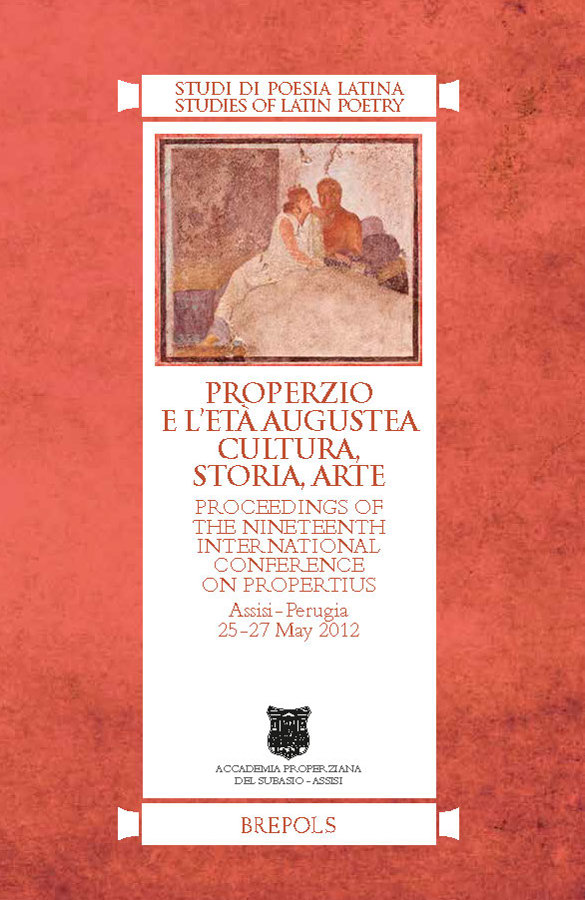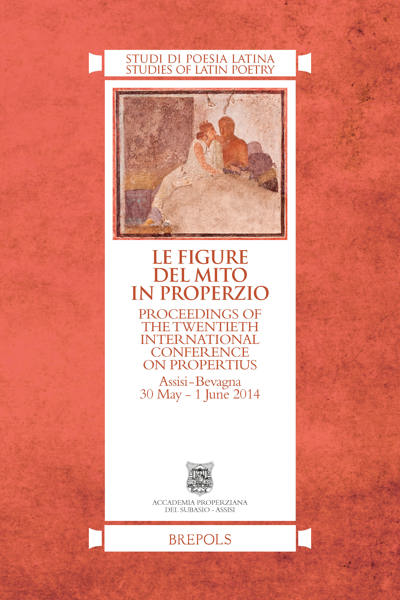
Properzio e l'età augustea. Cultura, storia, arte
Proceedings of the Nineteenth Conference on Propertius, Assisi - Perugia, 25-27 May 2012
Giorgio Bonamente, Carlo Santini, Roberto Cristofoli (eds)
- Pages: 466 p.
- Size:156 x 234 mm
- Illustrations:54 b/w, 2 tables b/w.
- Language(s):Italian, English
- Publication Year:2014
- € 125,00 EXCL. VAT RETAIL PRICE
- ISBN: 978-2-503-55301-6
- Paperback
- Available
- € 125,00 EXCL. VAT RETAIL PRICE
- ISBN: 978-2-503-57297-0
- E-book
- Available
A captivating overview of Roman poetry and society at the court of the Emperor Augustus on the 2000th anniversary of his death
"Si tratta, come si può facilmente intuire dalle parole spese in questa recensione, di un volume pregevole sia sotto il profilo metodologico sia dal punto di vista contenutistico: è un’opera da cui qualsiasi studioso dell’universo letterario di età augustea e della produzione properziana non può in alcun modo prescindere." (Alessia Cosenza, in: Bollettino di studi latini, 45, 2015, p. 750-754)
The 2000th anniversary of the death of Augustus provided an important occasion to reconsider the close relationship the poet Propertius and the town of Assisi had with the first emperor and the Roman world. With regard to Propertius, it was felt that the time had come to take stock of the growing interest in the Umbrian poet, and the speakers of the 2012 Conference (Properzio e l’età augustea: cultura, storia, arte) were invited to focus on two perspectives: the interwoven relationship between Propertius and Augustus, on the one hand, and his problematic interaction with the poets and literary circles of Rome on the other. The comparison with Augustus also called for the introduction of new data in the historical debate regarding the complex of monuments in the city of Assisi, from the Temple of Minerva, which dates back to the triumviral age, to the conspicuous epigraphic heritage of the gens Propertia, and archaeological landmarks such as the Domus Musae and the Domus del Lararium. Taking into account the multifarious stimuli hinted at these proceedings are to be read as a exchange of comparative assessments by philologists, the primary and legitimate custodians of the secretum of the poetry of Propertius, archaeologists, epigraphists and historians, called to define in dynamic terms – of imitation, assimilation and comparison – the relations the poet had with Rome and Augustus, with his hometown of Assisi and the Umbrian and Etruscan cities of the Umbrian Valley, and with the culture, art and the political groups active in triumviral and Augustan Rome.
Introduzione / Introduction (Giorgio Bonamente)
Riassunti degli articoli / Abstracts
Properzio e l’aristocrazia augustea (Werner Eck)
Domus assisiate di età augustea: la Domus del Lararium (Maria Laura Manca & Francesco Giorgi)
La gens Propertia e l’edilizia di età augustea ad Assisi: il caso della Domus Musae (Francesca Boldrighini)
Properzio e Cornelio Gallo: il modello “cogente”, il modello “sfuggente” (Luciano Landolfi)
Properzio e le guerre di conquista (Giovannella Cresci Marrone)
Properzio tra l’Etruria e Roma (Françoise Hélène Massa-Pairault)
Properzio e Mecenate (Roberto Cristofoli)
Il tempio di Apollo Palatino in Properzio e i suoi resti (Paul Zanker)
Properzio e Tibullo (Raffaele Perrelli)
Il Virgilio dei primi libri properziani (Arturo R. Álvarez Hernández)
Carmina Compono, Hic Elegos. Properzio e Orazio (Niklas Holzberg)
Ovidio e l’elegia di Properzio (Rosalba Dimundo)
Le puellae nelle elegie di Properzio e le loro omonime nei reperti epigrafici (Alison Keith)
Properzio tra scrittura e visualità. Un contributo alla genesi delle immagini di un poeta augusteo (Carlo Santini)
Da Cinzia a Cornelia (Paolo Fedeli)
Conclusioni (Giovanni Polara)
Appendice / Appendix




